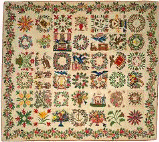Textile Society of America

Textile Society of America: Symposium Proceedings
Date of this Version
2004
Document Type
Article
Citation
Textile Society of America 9th Biennial Symposium, (2004).
Abstract
Cultural theorist Daniel Miller writes, “The deeply integrated place of the artefact in constituting culture and human relations has made discussion of it one of the most difficult of all areas to include in abstract academic discourse” (“Artefacts in Their Contexts,” Material Culture and Mass Consumption, Oxford 1987, p. 130). This is, however, the very task this discussion of nineteenth century Irish lace undertakes. This paper outlines the establishment of the lace industry in Ireland in such centers as Carrickmacross, Limerick and Youghal. It also examines both its makers and users, revealing how artefact can indeed provide a powerful symbolism of the cultural and human relations of which Miller writes. Lace is traditionally considered a symbol of the delicate and dainty, the rich, and the feminine. Yet studying it within its socio-historical context also reveals the hardship of the Irish people and the crux of social and political conditions that inspired the Irish Revolution of 1916 and continued violence throughout the twentieth century.


Comments
Presented at “Appropriation • Acculturation • Transformation,” Textile Society of America 9th Biennial Symposium, Oakland, California, October 7-9, 2004. Copyright 2004 Textile Society of America.